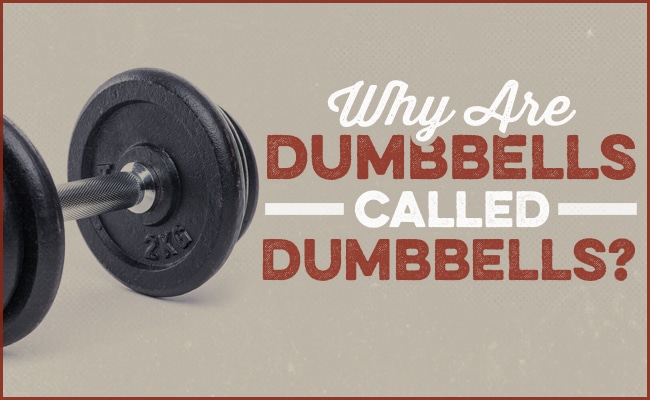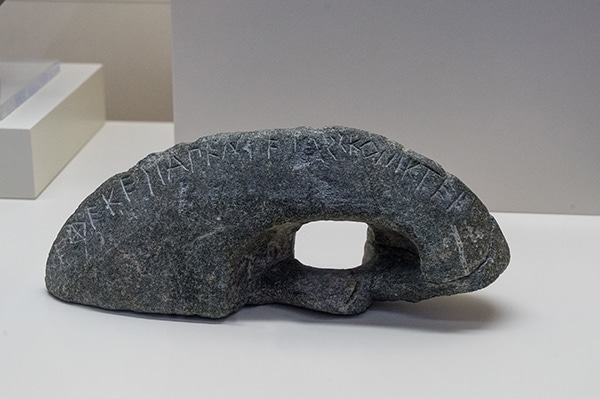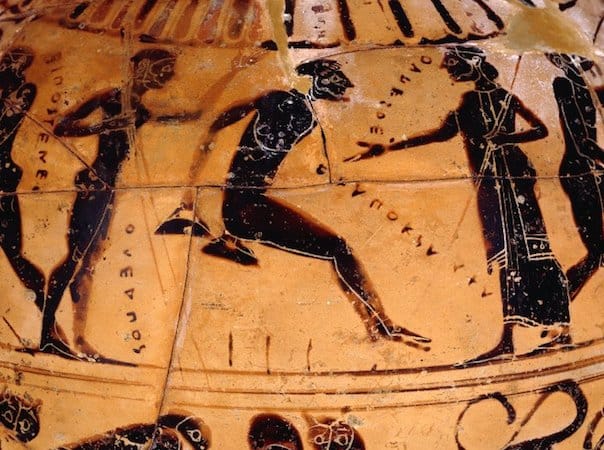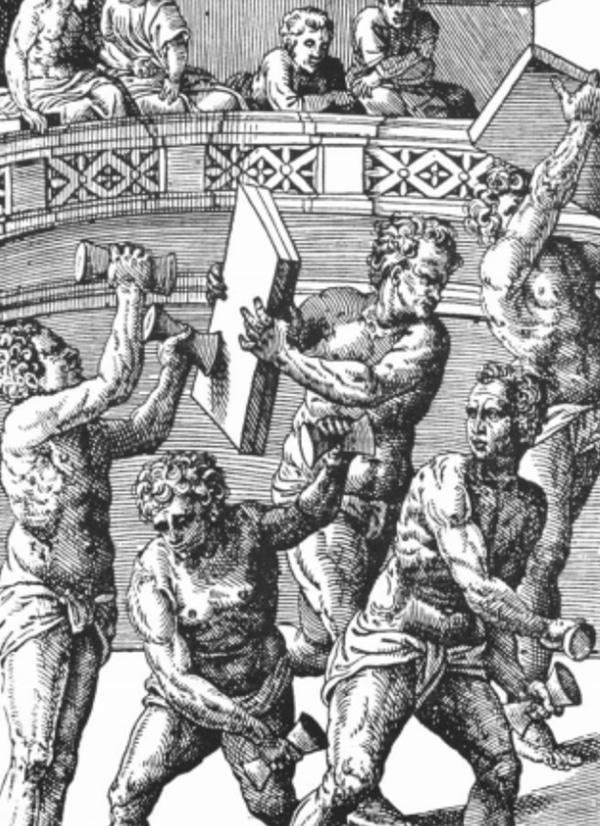[ad_1]

Dumbbells are a well-liked and efficient instrument for power coaching and train. They’re versatile, straightforward to make use of, and are available in numerous weights and sizes, making them appropriate for folks of all ages and health ranges.
You will get a full-body exercise with a set of dumbbells or use them as I do: as an adjunct to the primary barbell lifts. I really like doing Arnold shoulder presses and bicep curls with dumbbells.
However whereas doing a few of these curls the opposite day, I obtained to questioning: “Why are dumbbells known as dumbbells?”
I imply, it’s form of a bizarre title when you consider it.
I made a decision to research.
The Ur-Dumbbell: The Historic Greek Haltere
Not solely did the traditional Greeks give us democracy and advantage ethics, however additionally they bequeathed us the forerunner of what would turn out to be the fashionable dumbbell. Troopers and athletes would prepare with numerous weighted implements to get stronger. One in all these strength-training instruments was the haltere.

The haltere
The haltere assorted in form all through antiquity however mostly took the type of a semicircle with a gap in it; customers would place their fingers via the outlet to grip this piece of handheld train gear. Halteres have been sometimes constructed from stone and metallic however have been additionally made with wooden and wax; athletes would add result in these wood and waxen halteres to extend their weight.
Halteres have been used equally to how we use fashionable dumbbells. Athletes would maintain the weights whereas performing curls, lunges, and deadlifts. They’d additionally swing them round the way in which you’ll an Indian membership.

An historical Greek athlete holding halteres whereas doing the lengthy leap.
Halteres have been used for coaching within the lengthy leap as effectively. Athletes would maintain the weights of their palms and leap with them to construct up energy and power of their legs. They’d additionally use halteres to leap additional. As they jumped, they’d swing the halteres ahead to assist propel their momentum after which swing the weights backward, letting them go simply earlier than touchdown.
The Romans copied the Greeks and used halteres to coach their athletes and warriors. The Greek doctor Galen really helpful troopers make the most of halteres to get stronger.

Picture from De Arte Gymnastica Aput Ancientes displaying fashionable dumbbell-looking halteres.
Through the Renaissance, historical Greek and Roman coaching strategies noticed a revitalization. Well being books of the interval forwarded Galen’s suggestions for utilizing weighted implements for train, and the haltere discovered its means again into Western tradition. Crucial Renaissance guide that promoted power coaching with halteres was Mercurialis’ De Arte Gymnastica Aput Ancientes. Together with coaching regimens impressed by Hellenistic tradition, the guide comprises elaborate illustrations of jacked Greeks and Romans hoisting issues, together with halteres, to get stronger. However the halteres that Mercurialis depicted appeared totally different from the rectangular semicircles that precise Greeks and Romans used. As a substitute, they appeared like two cones caught collectively at their heads, forming a rod within the center you could possibly grasp.
They appeared like modern-day dumbbells.
Dumbbells Grow to be Dumbbells
Due to Mercurialis’ De Arte Gymnastica, by the 18th century, coaching with handheld weights grew to become a typical and accepted type of bodily train. However when did the haltere begin being known as a dumbbell, and why was it known as that?
Jan Todd, a professor of train historical past, has scoured the historic file on these questions and couldn’t come to a definitive reply.
However what she uncovered gives clues about how the haltere grew to become the dumbbell.
In 1711, the British poet and essayist Joseph Addison wrote this in his standard journal, The Spectator:
After I was some years youthful than I’m at current, I used to make use of myself in a extra laborious diversion…it’s there known as…the preventing with a person’s personal shadow; and consists within the brandishing of two brief sticks, grasped in every hand, and loaded with plugs of lead at both finish. This opens the chest, workout routines the limbs and offers a person all of the pleasure of boxing, with out the blows.
It appears like Addison was shadowboxing utilizing handheld weights that resemble what we all know as dumbbells. However in that essay, he by no means used “dumbbell” to consult with his hand weights.
Nonetheless, when describing one other of his train routines in a special essay in the identical subject of the journal, he does use the phrase “dumb bell”:
For my very own half, when I’m on the town, I train myself an hour each morning upon a dumb bell that’s positioned in a nook of my room, and [it] pleases me the extra as a result of it does every little thing I require of it in most profound silence. My landlady and her daughters are so effectively acquainted with my hours of train, that they by no means come into my room to disturb me while I’m ringing.

The dumb-bell train equipment, which was used even by a Founding Father. When Benjamin Franklin was 80, a good friend requested him in a letter what accounted for his longevity. Outdated Ben responded: “I stay temperately, drink no wine, and use day by day the train of the dumb-bell.”
When Addison says he was exercising himself upon a “dumb bell,” he was probably referring to a chunk of apparatus that included 4 arms with lead balls on their ends. The equipment was put in a stage above the one on which it will be used. A rope hooked up to the machine ran via the ground to the place the consumer stood beneath. He would pull the rope up and down, turning the equipment’ weighted arms like a flywheel. This rope-pulling motion resembled that used to ring an enormous bell (like a church bell), although this “ringing” didn’t, in fact, lead to any sound. Therefore, the machine was known as a “dumb bell” — “dumb” as in “doesn’t make a noise.”
So why did the title “dumb bell” get transferred from this piece of 18th-century train gear to haltere-esque handheld weights?
Maybe it was as a result of the arms on the dumb-bell equipment form of resemble the dumbbells we all know right now.
Or perhaps readers of Addison’s journal conflated the 2 articles he wrote collectively and began considering of the hand-held weights he referenced as “dumb bells” too.
The world could by no means know.
Whereas there isn’t a definitive reply as to when and why handheld weights grew to become referred to as dumbbells, it’s clear that by the tip of the 18th century, they have been often being known as such (the time period “barbell” wouldn’t arrive on the scene for an additional century).
It’s additionally clear that dumbbells have a health-enhancing, strength-improving monitor file that stretches from antiquity via the current day.
Lengthy could they proceed to be hoisted.
[ad_2]
Source link



